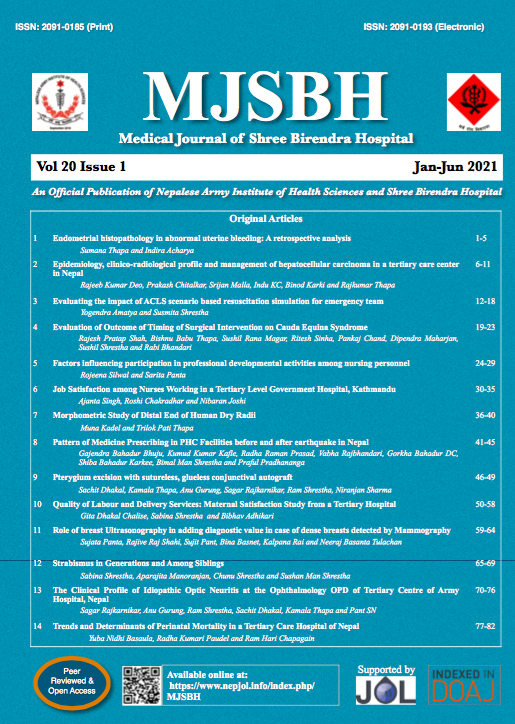Endometrial Histopathology in Abnormal Uterine Bleeding: A Retrospective Analysis
Keywords:
abnormal uterine bleeding; dilatation and curettage; histopathologyAbstract
Introduction: Abnormal uterine bleeding (AUB) is a very common gynaecological condition that affects women of all age groups. Majority of the cases are diagnosed by sampling the endometrium by procedure like dilatation and curettage (D and C). The aim of this study was to analyse the different types of endometrial histopathology of patients with the abnormal uterine bleeding and to find the association between various patterns of abnormal uterine bleeding and histopathological findings.
Methods: This was a retrospective study carried out in the Department of Obstetrics and Gynaecology of Shree Birendra Hospital, Chhauni, Kathmandu over a period of two years from August 2018 to August 2020. All cases of AUB who underwent D and C procedure were included in the study. Data was entered in Microsoft excel and managed in SPSS Version 21. Analysis was done in the form of percentage and proportion and represented as tables where necessary.
Results: Total 192 patients were analysed. Age group ranged from 21 to 75 years and most common age group presenting with AUB was 41 to 50 years. The most common presenting complaint was menorrhagia 47.9% (92/192) followed by metrorrhagia 19.8% (38/192). Most common endometrial histopathology was proliferative endometrium 33.3% (64/192), followed by secretory endometrium 21.9 % (42/192). Endometrial malignancy was found in 1.5% (3/192) cases.
Conclusions: Histopathological examination of the endometrium showed a wide spectrum of pathological changes ranging from normal endometrium to malignancy. This emphasises the importance of endometrial sampling like D and C as an important diagnostic tool in the management of abnormal uterine bleeding.
Downloads
Downloads
Published
How to Cite
Issue
Section
License
This license enables reusers to distribute, remix, adapt, and build upon the material in any medium or format for noncommercial purposes only, and only so long as attribution is given to the creator.




